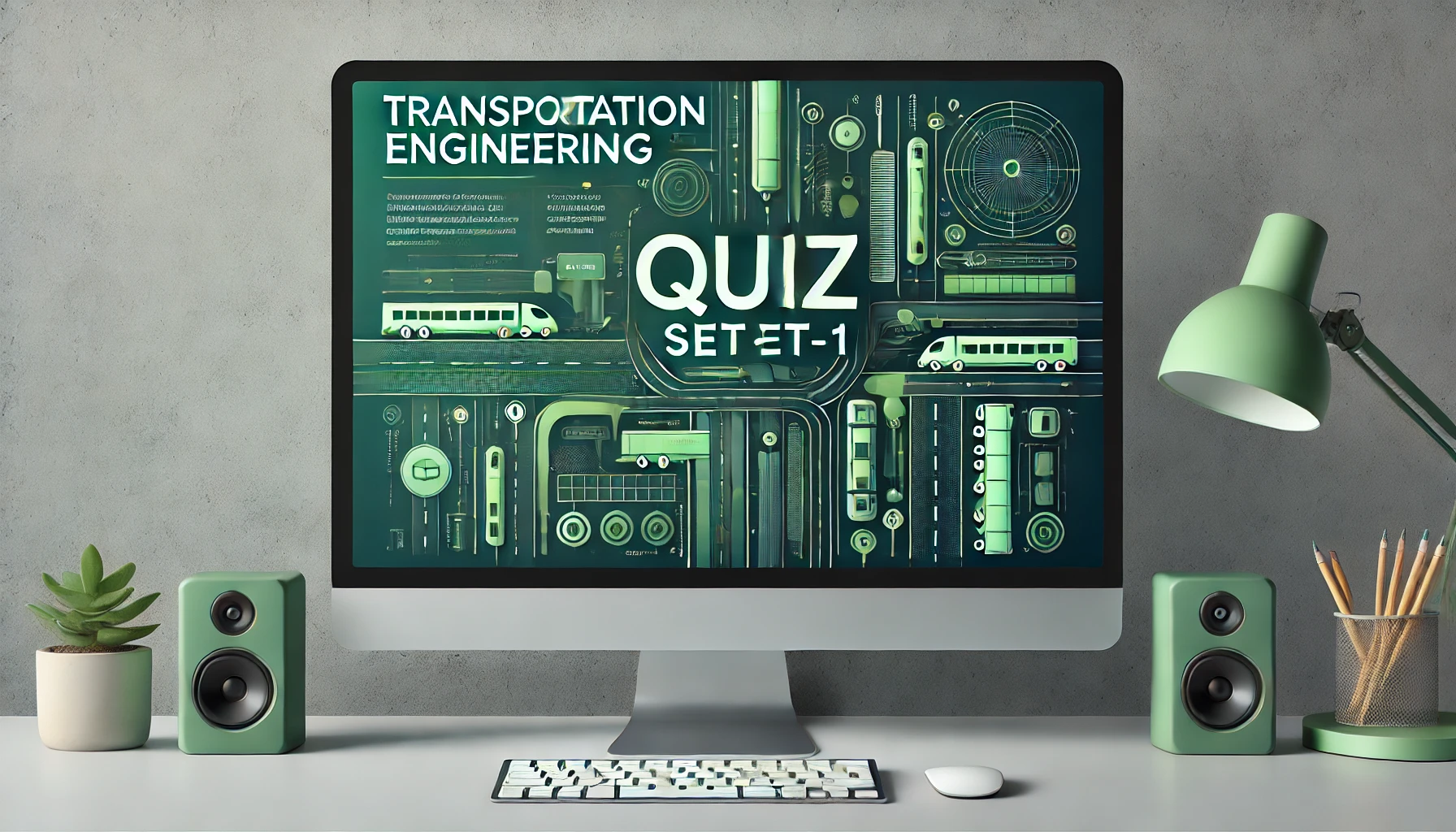Welcome to “Transportation Engineering Quiz Set-1 [2025]!”
In this blog, we’ve curated 50+ thought-provoking multiple-choice questions covering the fundamental and advanced concepts of transportation engineering. “Transportation Engineering Quiz Set-1 [2025]” is designed to help you refresh your basics, challenge your knowledge, and gain practical insights into the techniques and principles of transportation systems.
Whether you’re a civil engineering student, a transportation professional, or preparing for competitive exams, this quiz is the perfect way to enhance your expertise in transportation engineering.
Let’s dive into the “Transportation Engineering Quiz Set-1 [2025]” and start exploring!
Transportation Engineering: A Comprehensive Guide
Transportation engineering is a branch of civil engineering that focuses on the planning, design, operation, and maintenance of transportation systems. These systems include roads, highways, railways, airports, and public transit networks. As cities grow and populations increase, the demand for efficient and sustainable transportation solutions becomes more critical than ever. In this blog, we delve into the principles, applications, and future of transportation engineering.
What is Transportation Engineering?
Transportation engineering is the study of how to efficiently move people and goods from one place to another. It involves the application of scientific principles and technology to design and maintain transportation infrastructure. This field encompasses various modes of transportation, including:
- Roadways: Design and maintenance of roads, highways, and intersections.
- Railways: Planning and operation of train networks.
- Airways: Design and management of airports and air traffic systems.
- Waterways: Development of ports and shipping lanes.
- Public Transit: Designing efficient bus and metro systems.
The goal of transportation engineering is to create safe, efficient, and sustainable systems that meet the needs of modern society.
See Also: Steel Structures Quiz Set-1
Key Principles of Transportation Engineering
Transportation engineering is built on several fundamental principles:
- Safety: Ensuring the safety of all users, including pedestrians, cyclists, and motorists.
- Efficiency: Optimizing the flow of traffic and reducing congestion.
- Sustainability: Minimizing the environmental impact of transportation systems.
- Accessibility: Ensuring that transportation systems are accessible to all, including people with disabilities.
- Cost-effectiveness: Balancing performance and budget constraints.
Applications of Transportation Engineering
1. Traffic Engineering
Traffic engineering focuses on the management and control of vehicular and pedestrian traffic. It involves:
- Designing traffic signals and signs.
- Conducting traffic flow studies.
- Implementing intelligent transportation systems (ITS).
2. Highway Engineering
Highway engineering deals with the design, construction, and maintenance of roads and highways. This includes:
- Pavement design.
- Geometric design of roads.
- Drainage systems.
3. Railway Engineering
Railway engineering involves the design and operation of rail networks, including:
- Track alignment and construction.
- Signal systems.
- Station design.
4. Airport Engineering
Airport engineering focuses on the planning and design of airports, including:
- Runway and taxiway design.
- Terminal facilities.
- Air traffic control systems.
5. Urban Transportation Planning
Urban transportation planning aims to create efficient public transit systems. Key aspects include:
- Bus rapid transit (BRT) systems.
- Metro rail systems.
- Pedestrian and cycling infrastructure.
See Also: Concrete Structures Quiz Set-1
Challenges in Transportation Engineering
1. Urbanization
As cities expand, transportation systems face increased pressure to accommodate growing populations.
2. Environmental Impact
Transportation contributes significantly to greenhouse gas emissions. Engineers must design eco-friendly solutions.
3. Technological Advancements
The integration of autonomous vehicles, smart infrastructure, and electric vehicles presents both opportunities and challenges.
4. Funding Constraints
Limited budgets often hinder the development and maintenance of transportation infrastructure.
Future Trends in Transportation Engineering
1. Smart Transportation Systems
The use of IoT (Internet of Things) and AI to optimize traffic flow and manage transportation networks.
2. Sustainable Transportation
Increased focus on electric vehicles, renewable energy, and green infrastructure.
3. Autonomous Vehicles
The rise of self-driving cars and their impact on road design and traffic management.
4. Integrated Mobility
Developing seamless multi-modal transportation systems that integrate various modes of travel.
See Also: Engineering Mechanics Quiz Set-1
FAQs About Transportation Engineering
1. What does a transportation engineer do?
A transportation engineer designs, develops, and maintains transportation systems to ensure safe and efficient movement of people and goods.
2. Why is transportation engineering important?
Transportation engineering is crucial for economic growth, environmental sustainability, and improving the quality of life by providing efficient and safe mobility.
3. What are the main challenges in transportation engineering?
Key challenges include urbanization, environmental concerns, technological advancements, and funding constraints.
4. What are the career opportunities in transportation engineering?
Career opportunities include roles in traffic engineering, highway design, urban planning, and transportation consulting.
5. How does technology impact transportation engineering?
Technology enables smart transportation systems, autonomous vehicles, and efficient traffic management, revolutionizing the field.
